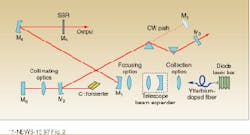SOLID-STATE ULTRAFAST LASERS: Fiber laser pumps ultrafast Cr:forsterite
A double-clad fiber laser converts multimode input power from a diode laser bar into wavelength-shifted single-mode output to pump a femtosecond chromium-doped forsterite (Cr4+:forsterite) laser. The design shows potential as a high-power turnkey system for biological imaging applications, including nonlinear laser microscopy.
Researchers working to develop Cr:forsterite lasers that do not rely on bulky pump sources such as large-frame, water-cooled ion or Nd:YAG lasers have investigated several alternatives. Diode-pump ed solid-state lasers, for example, have been successfully demonstrated as compact, stable, efficient sources for various uses. Master-oscillator power-amplifier (MOPA) configurations provide one alternative pump source, but commercial availability is limited, and the output power of these devices remains below 1 W.
Broad-area diodes are another pump source, but power is again a limitation. Diode-laser bars appear to offer a solution to the problem of pump power, but conditioning the output of a diode bar to achieve an appropriately small, single-mode focal spot for pumping is a nontrivial task.
Double-clad fiber pump laser
Frank Wise and collaborators at Cornell University (Ithaca, NY) have demonstrated the effectiveness of a double-clad fiber laser as a 1.1-µm pump source for Cr:forsterite. The fiber laser approach offers several advantages over direct diode pumping.
The fiber laser converts the multimode output of the diode laser bar into a beam with a single transverse mode—because the single-mode fiber core constrains the output of the pump laser to a single transverse mode, performance is independent of environment, output power, and aging effects. The fiber laser also shifts the output wavelength of the diode laser bar to one that falls within the absorption band of Cr4+. The conversion efficiency of the fiber laser is 60%. Thermal loading is not an issue and does not, therefore, limit generation of high output powers. Finally, the device is compact and robust.
The system consists of an 8-µm-diameter ytterbium (Yb)-doped core surrounded by a 170 × 330-µm rectangular cladding comprising an inner glass layer cladded by a polymer layer (see Fig. 1). Optical power from the diode bar propagates along the inner cladding layer to pump the doped core.
Excited by 13.8 W of output from an indium gallium arsenide (InGaAs) diode laser bar emitting at 915 nm, the fiber laser produces 9 W of TEM00 output at approximately 1.11 µm and requires no cooling. Optics collect and relay the output to a beam expander, then focus the beam onto the Cr:forsterite crystal.
The Cr:forsterite laser consists of a five-mirror cavity design (see Fig. 2). At 1.25 µm and in continuous-wave mode the system produced maximum powers of 185 mW, for a 9% slope efficiency (5% output coupler). To increase pump power absorption, the group reflected the transmitted pump beam back into the crystal with an additional flat mirror, raising absorption 20% to approximately 62% and achieving a maximum output power of 212 mW.Turnkey system sought
The intent of the group's research is to produce a femtosecond turnkey system for nonresearch applications. To simplify operation, the group replaced the output coupler with a saturable Bragg reflector to induce self-starting Kerr-lens modelocking (KLM). Achieving KLM at 90 MHz, the laser generated transform-limited pulses with durations of approximately 80 fs and a maximum output power of 68 mW. The output is extremely stable, as a result of the stability of the fiber laser, which has power fluctuations of only 0.1%
Future work includes pumping the crystal with a neodymium-doped fiber to provide pump output at 1.06 µm, which better matches the Cr4+ absorption band, and increasing the Cr4+ doping levels. Wise estimates that an improved and optimized system should generate 100-fs pulses with average output powers of 300 mW or better.
Kristin Lewotsky | Associate Editor (1994-1997)
Kristin Lewotsky was an associate editor for Laser Focus World from December 1994 through November 1997.

